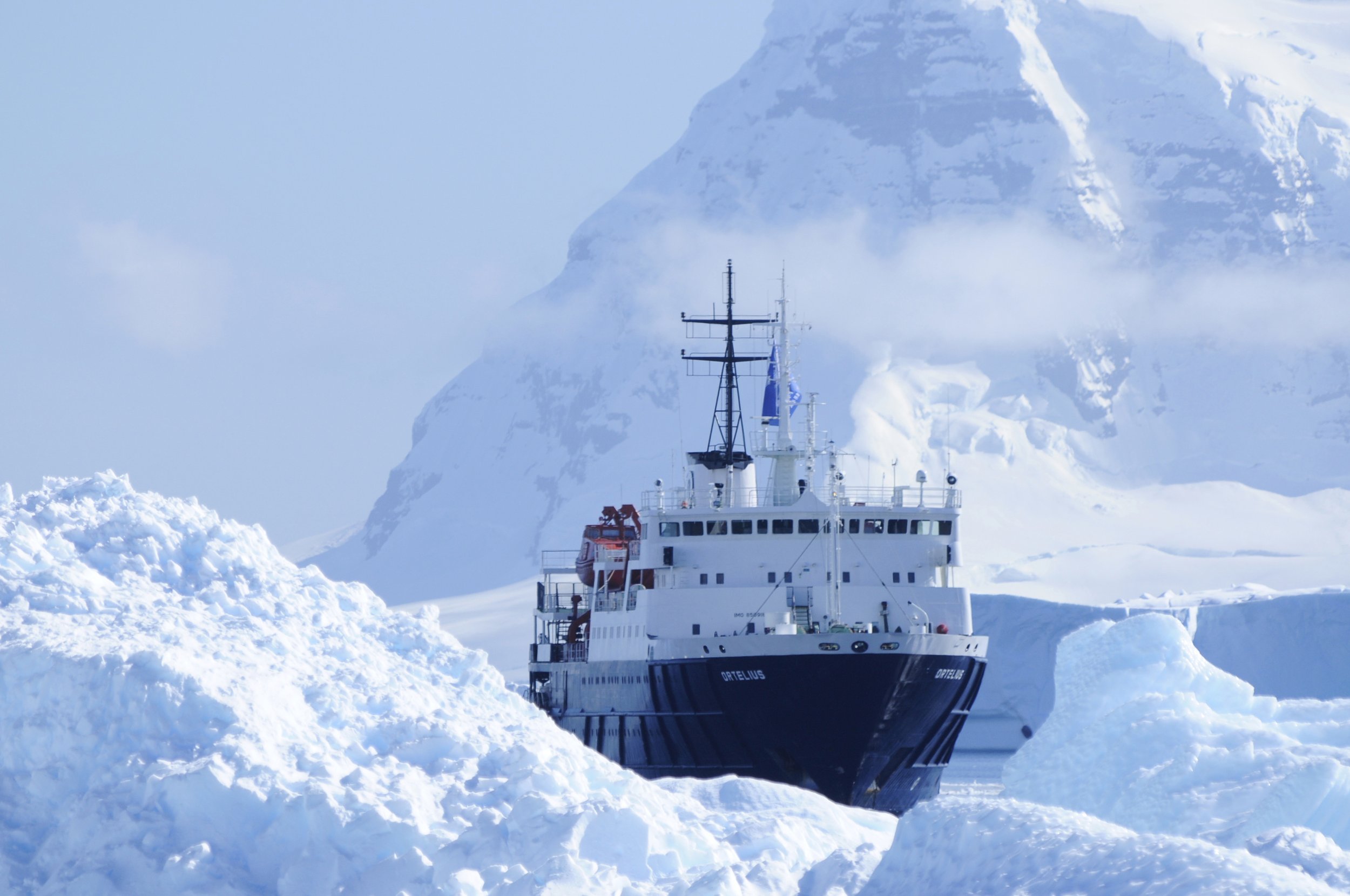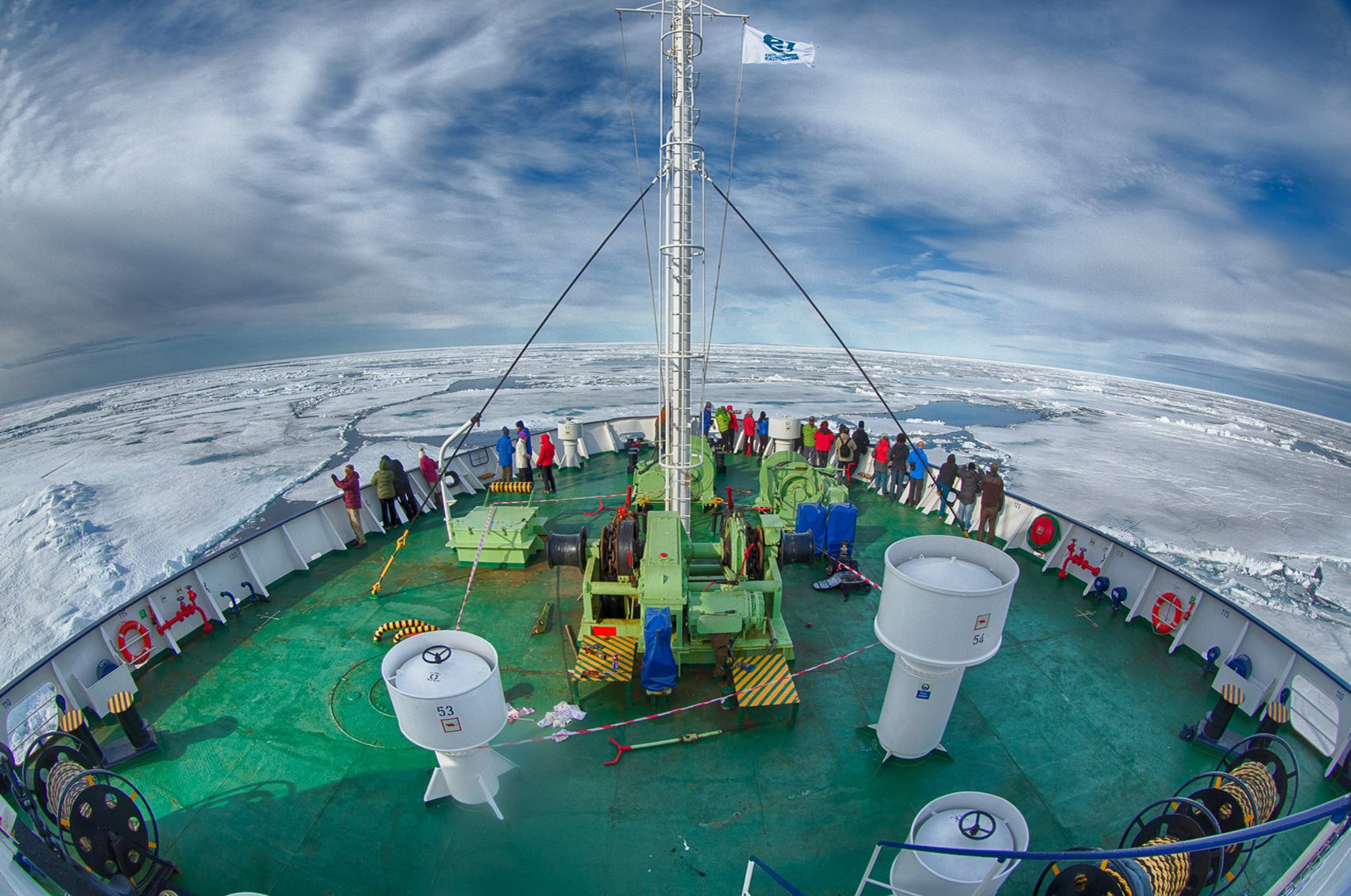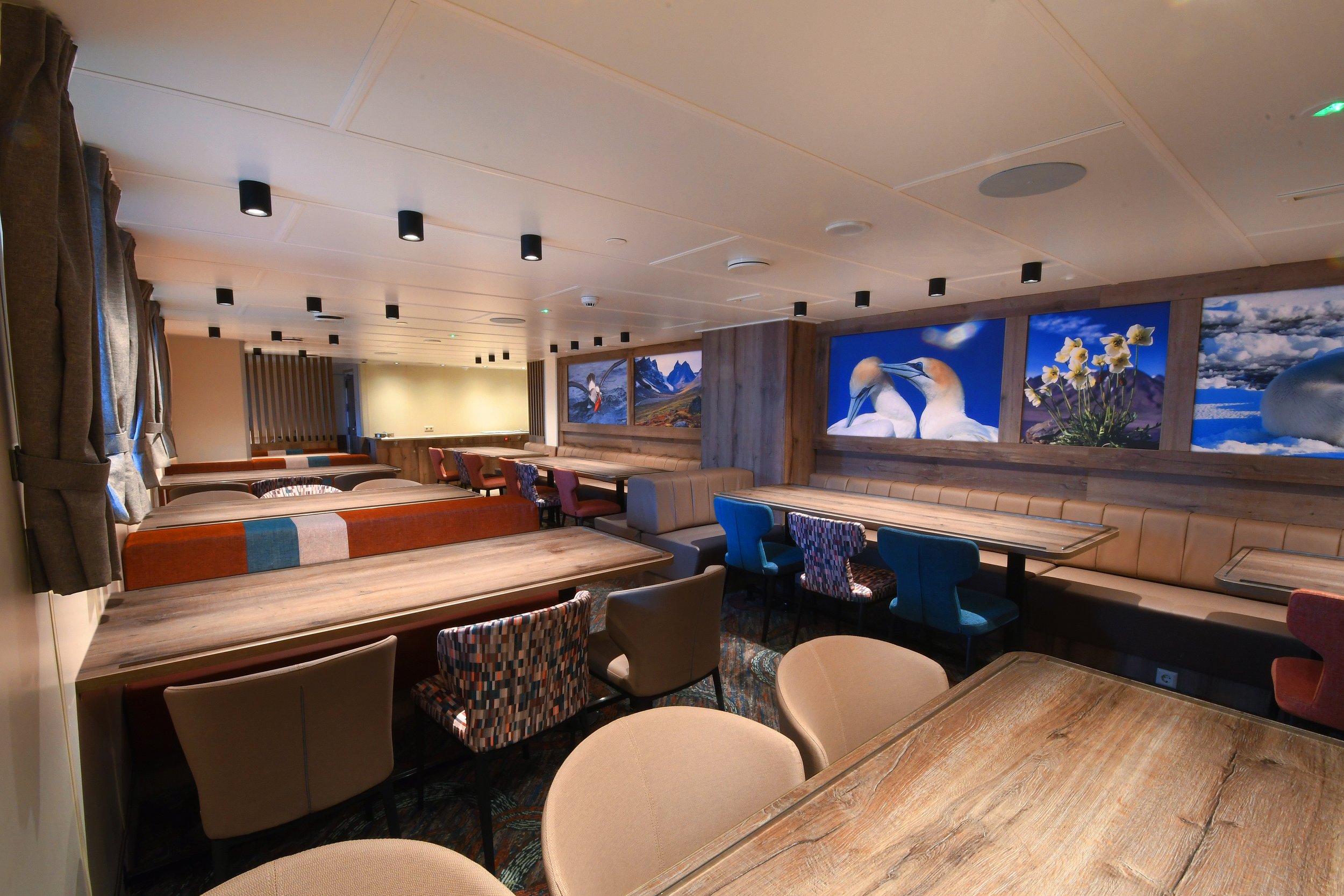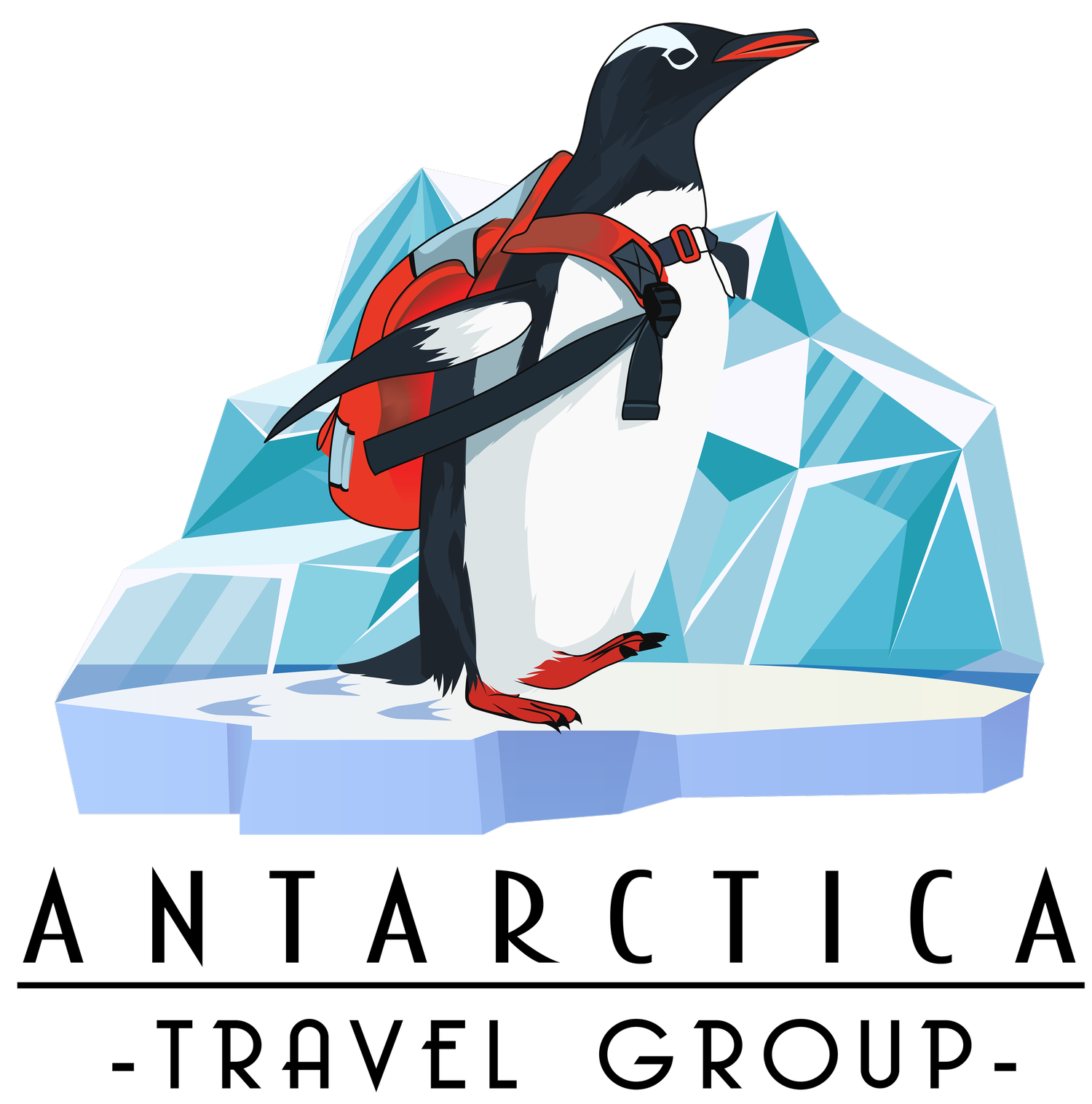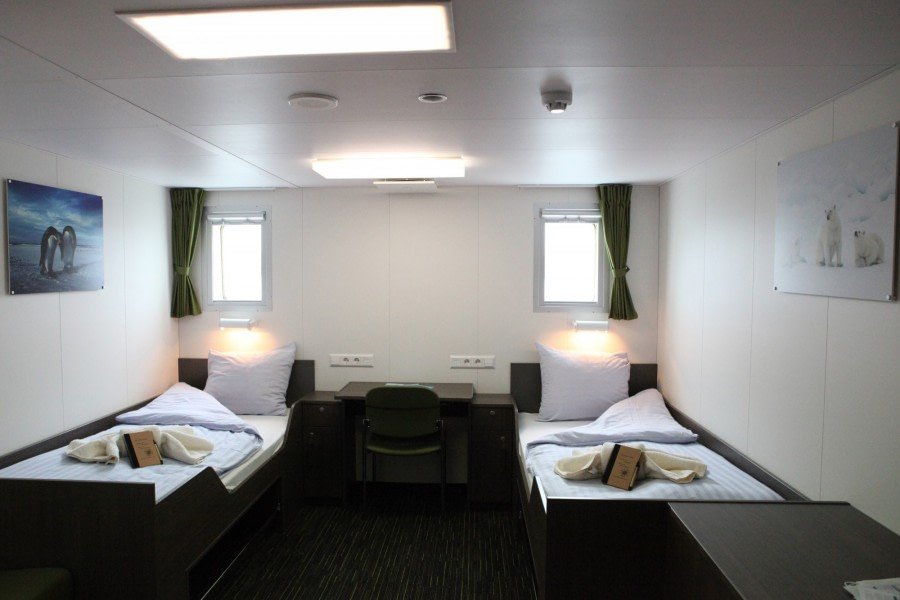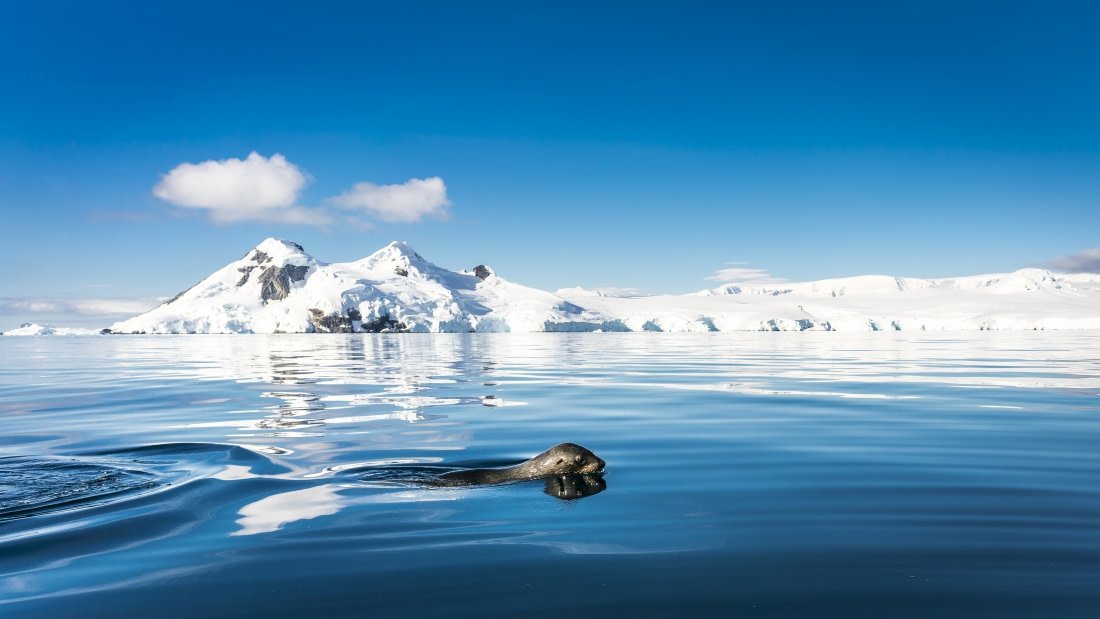
Falkland Islands, South Georgia & Antarctica
Twenty one day Falkland Islands , South Georgia & Antarctica aboard m/v Ortelius Ship with Oceanwide Expeditions
Duration: 21 Days / 20 Nights
Itinerary: Falkland Islands, South Georgia & Antarctica
Departing/Returning: Puerto Madryn / Ushuaia Argentina
Passengers: 108*
Ship name: m/v Ortelius
Departures:
22 Oct - 11 Nov, 2025
Dates and Details.
A cruise to the Falkland Islands, South Georgia & the Antarctic Peninsula. Visit some of the most beautiful arrays of wildlife on Earth. This journey will introduce you to at least 6 species of penguin and a whole lot of Antarctic fur seals!
Trip Description.
-
Day 1: Sandy Argentine beaches
You embark from Puerto Madryn in the afternoon, your prow aimed for the Falkland Islands. Golfo Nuevo is renowned for its visiting southern right whales, so you have a good chance of spotting one as you sail toward the open ocean.
Day 2 – 3: Sea life, sea birds
Though you’re now at sea, there’s rarely a lonesome moment here. Several species of bird follow the vessel southeast, such as albatrosses, storm petrels, shearwaters, and diving petrels.
Day 4: Finding the Falklands
The Falkland Islands offer an abundance of wildlife that is easily approachable, though caution is always advised. These islands are largely unknown gems, the site of a 1982 war between the UK and Argentina. Not only do various species of bird live here, but chances are great you’ll see both Peale’s dolphins and Commerson’s dolphins in the surrounding waters.
During this segment of the voyage, you may visit the following sites:
Steeple Jason – Home to the world’s largest black-browed albatross colony (roughly 113,000), Steeple Jason is a wild and rarely visited island buffeted by wind and waves. Weather and swell conditions dictate the journey here.
Carcass Island – Despite its name, this island is pleasantly rodent-free and hence bounteous with birdlife and many endemic species. Anything from breeding Magellanic penguins and gentoos to numerous waders and passerine birds (including Cobb’s wrens and tussock-birds) live here.
Saunders Island – On Saunders Island you can see the black-browed albatross and its sometimes-clumsy landings, along with breeding imperial shags and rockhopper penguins. King penguins, Magellanic penguins, and gentoos are also found here.
Day 5: The seat of Falklands culture
The capital of the Falklands and center of its culture, Port Stanley has some Victorian-era charm: colorful houses, well-tended gardens, and Englishstyle pubs are all to be found here. You can also see several century-old clipper ships nearby, silent witnesses to the hardships of 19th century sailors. The small but interesting museum is also worth a visit, covering the early days of settlement up to the Falklands War. Approximately 2,100 people live in Port Stanley. Admission to the museum is included.
Day 6 – 7: Once more to the sea
En route to South Georgia, you now cross the Antarctic Convergence. The temperature cools considerably within the space of a few hours, and nutritious water rises to the surface of the sea due to colliding water columns. This phenomenon attracts a multitude of seabirds near the ship, including several species of albatross, shearwaters, petrels, prions, and skuas.
Day 8 – 11: South Georgia journey
Today you arrive at the first South Georgia activity site. Please keep in mind that weather conditions in this area can be challenging, largely dictating the program.
Sites you might visit include:
Salisbury Plain, St. Andrews Bay, Gold Harbour – These sites not only house the three largest king penguin colonies in South Georgia, they’re also three of the world’s largest breeding beaches for southern elephant seals. Only during this time of year do they peak in their breeding cycle. Watch the four-ton bulls keep a constant vigil (and occasionally fight) over territories where dozens of females have just given birth or are about to deliver. You can also see a substantial number of Antarctic fur seals here during the breeding season (December – January).
Fortuna Bay – A beautiful outwash plain from Fortuna Glacier is home to a large number of king penguins and seals. Here you may also have the chance to follow the final leg of Shackleton’s route to the abandoned whaling village of Stromness. This path cuts across the mountain pass beyond Shackleton’s Waterfall, and as the terrain is partly swampy, be prepared to cross a few small streams.
Grytviken – In this abandoned whaling station, king penguins walk the streets and elephant seals lie around like they own the place – because they basically do. Here you might be able to see the South Georgia Museum as well as Shackleton’s grave.
In the afternoon of day 11 and depending on the conditions, we will start sailing southwards in the direction of the South Orkney Islands.
Day 12: Southward bound
There may be sea ice on this route, and at the edge of the ice some south polar skuas and snow petrels could join the other seabirds trailing the vessel south.
Day 13: The scenic vistas of South Orkney
Depending on the conditions, you might visit Orcadas Base, an Argentine scientific station on Laurie Island in the South Orkney archipelago. The personnel here will happily show you their facility, where you can enjoy expansive views of the surrounding glaciers. If a visit isn’t possible, you may instead land at Signy Island’s Shingle Cove.
Day 14 - 15: Entering the Antarctic
Enormous icebergs and a fair chance of fin whale sightings ensure there’s never a dull moment on this last sea voyage south. Also, your best chance to spot Antarctic petrels is here. Depending on conditions, we aim to begin activities the afternoon of day 15.
Day 16 – 18: Awe-inspiring Antarctica
If the ice conditions permit, you now sail into the Weddell Sea. Here colossal tabular icebergs herald your arrival to the eastern side of the Antarctic Peninsula. Paulet Island, with its large population of Adélie penguins, is a possible stop. You might also visit Brown Bluff, located in the ice-clogged Antarctic Sound, where you could get the chance to set foot on the Antarctic Continent itself.
If conditions aren’t favorable to enter the Weddell Sea from the east, the ship will set course for Elephant Island and head into the Bransfield Strait, between the South Shetland Island's and the Antarctic Peninsula.
The volcanic islands of the South Shetlandsare windswept and often cloaked in mist, but they nonetheless offer many subtle pleasures. A wide variety of flora (mosses, lichens, flowering grasses) and fauna (gentoo penguins, chinstrap penguins, southern giant petrels) live here.
On Half Moon Island, Chinstrap penguins and Weddell seals often haul out onto the beach near Cámara Base, an Argentine scientific research station.
On Deception Island, the ship plunges through Neptune’s Bellows and into the flooded caldera. Here you can find an abandoned whaling station, and thousands of cape petrels. A number of kelp gulls, brown skuas, south polar skuas, and Antarctic terns can be spotted too. Wilson’s storm petrels and black-bellied storm petrels also nest in the ruins of the whaling station in Whalers Bay. As an alternative, you can take part in activities near Telefon Bay, further inside the caldera.
This extended voyage gives you the chance to sail even farther down the icy coast of the western Antarctic Peninsula. There are several opportunities for great landings where you might set foot on the Antarctic Continent, surrounded by an epic landscape of alpine peaks and mammoth glaciers calving at sea level. Gentoo penguins, leopard seals, Weddell seals, humpback whales, and minke whales are often seen here.
The breathtaking scenery continues in the Bransfield Straight and, if conditions allow further South in the Gerlache Strait. Conditions on the Drake Passage determine the exact time of departure.
Day 19 – 20: Familiar seas, familiar friends
Your return voyage is far from lonely. While crossing the Drake, you’re again greeted by the vast array of seabirds remembered from the passage south. But they seem a little more familiar to you now, and you to them.
Day 21: Earth’s southernmost city
You arrive and disembark in Ushuaia, commonly held to be the world’s most southern city. It is located on the Tierra del Fuego archipelago, nicknamed the “End of the World.” But despite this stopping point, the wealth of memories you’ve made on your Antarctic expedition will travel with you wherever your next adventure lies.
-
Flora and Fauna of the South Orkney Islands
Despite their rugged conditions, these islands support a diverse and dynamic ecosystem
Stanley
The capital of the Falkland Islands and a common stop during our voyages in this area
Carcass Island
Contrary to what its name may suggest, Carcass Island is a lively place for viewing breeding Magellanic and gentoo penguins
Grytviken
An impressive remnant of early 20th-century whaling, Grytviken is a well-preserved former station abandoned by Norwegian hunters after they had exhausted the local whale population
Salisbury Plain
Known for its colossal king penguin colony, Salisbury Plain is a longstanding favorite in our South Georgia expeditions
Elephant Island
Named both for its elephant-head shape and the seals that once populated its shores, this icy-peaked island lies near the tip of the Antarctic Peninsula
Gentoo Penguin
These hygienic divers are the only penguin species whose population is currently increasing along the Antarctic Peninsula
King Penguin
Second in size only to the emperor penguin, these colorful divers look so different than their own chicks that they were once thought to be a different species
Magellanic Penguin
These timid feather-shedders are named after the famed Portuguese explorer whose crew spotted them in 1520
Rockhopper Penguin
One moment these golden-haired divers are sleeping on the water, the next they can be swimming so fast they launch themselves ashore onto their bellies
Weddell Seal
Named after the British navigator and sailor James Weddell, these extensively studied seals live farther south than any other mammal
Black-browed Albatross
So efficient in the air that their in-flight heart rate barely rises above resting, these sub-Antarctic birds pack a stomach full of oil they can spit at would-be attackers
-
INCLUSIONS
Voyage aboard the indicated vessel as indicated in the itinerary
All meals throughout the voyage aboard the ship including snacks, coffee and tea.
All shore excursions and activities throughout the voyage by Zodiac.
Program of lectures by noted naturalists and leadership by experienced expedition staff.
Free use of rubber boots and snowshoes.
Pre-scheduled group transfer from the vessel to the airport in Ushuaia (directly after disembarkation).
All miscellaneous service taxes and port charges throughout the programme.
Comprehensive pre-departure material.
EXCLUSIONS
Any airfare, whether on scheduled or charter flights
Pre- and post- land arrangements.
Passport and visa expenses.
Government arrival and departure taxes.
Meals ashore.
Baggage, cancellation and personal insurance (which is strongly recommended).
Excess baggage charges and all items of a personal nature such as laundry, bar, beverage charges and telecommunication charges.
The customary gratuity at the end of the voyages for stewards and other service personnel aboard (guidelines will be provided).
-
A deposit of 25% is required to hold your spot within 14 days of being invoiced and final payment is due 90 days before departure. Payment can be made via bank transfer or debit and credit card. Cards accepted are Visa or Mastercard.
Voyage Map.
Embark from Puerto Madryn, aiming for the Falkland Islands, with potential southern right whale sightings in Golfo Nuevo. Upon reaching the Falkland Islands, explore Steeple Jason, Carcass Island, and Saunders Island. Visit Port Stanley. Cross the Antarctic Convergence en route to South Georgia, visiting key sites such as Salisbury Plain, St. Andrews Bay, Gold Harbour, Fortuna Bay, and Grytviken. Sail towards the South Orkney Islands, possibly visiting Orcadas Base on Laurie Island or Signy Island's Shingle Cove. Enter Antarctica, with potential stops at Paulet Island, Brown Bluff, the South Shetland Islands, Half Moon Island, Deception Island, and further explorations down the western Antarctic Peninsula. The voyage concludes with a return to Ushuaia, the southernmost city on Earth.
-
Will we get off the ship?
Yes!!! Once we arrive in Antarctica it will be the ultimate goal of the Captain, Expedition Leader, and the Expedition Team to make sure we get off the ship as much as possible. You’ll participate in landings, zodiac cruises, and any additional activities you’ve signed up for. Check the “Detailed trip itinerary” below for more details on each outing.
*Pending weather.
-
Are there additional taxes and fees?
The price shown is the "all-in” price after all taxes, fees, port fees, and permits required; which are handled by the tour operator. The only main additional costs will be mandatory travel insurance, optional gratuity, canned beverages and alcohol, and additional activities. See the full list of inclusions/exclusions for more.
-
Do I pay extra if I'm a solo traveler?
Not necessarily, no! Our group trips are usually made up of around 50% solo travelers! Prices are always per person, per bed. If you’re a solo traveler, we will match you with a same-gender roommate from our group to share your cabin with. There is also the option for solo cabin availability on certain trips. Please send us a message about solo cabins if that’s your preference.
Pricing
All prices are per person and include all taxes, fees, port fees, accommodation and meals.
Please refer to the full list of inclusions and exclusions for more details.
Why do I need to Email for ATG Price?
Antarctica Travel Group organizes group trips that allow us to offer discounted rates. We can’t post these prices publicly due to agency agreements and price match policies. Pricing needs to remain publicly consistent.
Please email for our discounted rates.
Quadruple Porthole
Featuring two portholes for scenic views, and two upper/lower berths for sleeping. A private shower and toilet, desk and chair, and flatscreen TV ensure your space is both functional and comfortable.
Modern amenities include a telephone and WiFi (supplemented), along with a hair dryer, safe deposit box, and ample storage space to accommodate your essentials, making your stay on board seamless and enjoyable.
Triple Porthole
Two portholes, one upper/lower berth plus an additional single lower berth, ensuring restful sleep. It includes a private shower and toilet, desk and chair for personal space, and a flatscreen TV for entertainment. Stay connected with a telephone and supplemented WiFi. Additional amenities like a hair dryer, safe deposit box, and ample storage space make your stay convenient and organized.
Twin Porthole
Two portholes, two lower berths, and a private shower and toilet. It's furnished with a desk and chair, and equipped with a flatscreen TV, telephone, and supplemented WiFi. Additional amenities include a hair dryer, safe deposit box, and plenty of storage space, ensuring a comfortable and convenient stay.
Twin Window
Features two windows for ample natural light, two lower berths for restful sleep, and a private shower and toilet. It's furnished with a desk and chair, and includes a flatscreen TV, telephone, and supplemented WiFi for connectivity and entertainment. Additional amenities like a hair dryer, safe deposit box, and generous storage space ensure a comfortable and convenient stay.
Twin Deluxe
Features two lower berths for restful sleep, a private shower and toilet, and a desk and chair for workspace or dining. A small sofa provides a cozy seating area, while a refrigerator, coffee & tea maker, and flatscreen TV add home-like comforts. Stay connected with telephone and supplemented WiFi, and enjoy the convenience of a hair dryer, safe deposit box, and plenty of storage space for your belongings.
Superior
Two windows, a double bed, and a single sofa bed, ensuring comfort for all occupants. It features a private shower and toilet, desk and chair, and a flatscreen TV for relaxation. Modern amenities include a telephone, supplemented WiFi, a refrigerator, and a coffee & tea maker. Additional conveniences are provided by a hair dryer, safe deposit box, and ample storage space, creating a well-equipped and comfortable environment.
Cabins may vary and may not be exactly as depicted. Please consult the deck plan and contact your booking agent for further information.
Ship Details.
The m/v Ortelius was built in Gdynia, Poland in 1989.
Ortelius was originally the Marina Svetaeva. Built in Gdynia, Poland in 1989, it served as a special-purpose vessel for the Russian Academy of Science. Later it was re-flagged and renamed after the Dutch/Flemish cartographer Abraham Ortelius (1527 – 1598), who in 1570 published the first modern world atlas: Theatrum Orbis Terrarum or Theater of the World. At that time his atlas was the most expensive book ever printed. Ortelius is classed by Lloyd’s Register in London and flies the Dutch flag.
The Ortelius carries 108 passengers in 50 cabins
-
Perfect for any expedition
The vessel has the highest ice-class notation (UL1, equivalent to 1A) and is therefor suitable to navigate in solid one-year sea ice as well as loose multi-year pack ice. Ortelius can accommodate up to 108 passengers and has an abundance of open-deck spaces. It is manned by 24 highly experienced nautical crew members, 20 hotel staff, eight expedition specialists (one expedition leader, one assistant, and six lecturer-guides), and one doctor.
Ortelius: a Vessel with Comfort and Character
Please be aware that a small number of cabins may have a partially obstructed view due to the size of the windows and the design requirements of the ship. For example, some windows may be partly obstructed in the lower half by a gangway. The best view is always on the outer deck or the bridge. Though our voyages are primarily meant to offer our passengers an exploratory wildlife program with as much time ashore as possible, Ortelius offers all the comforts of a standard hotel ― along with a bar and lecture room. Flexibility assures maximum wildlife opportunities. As such, Ortelius carries 10 Zodiacs with 60hp Yamaha engines.
Age and Nationality
Passengers on a typical voyage range from in their 30s to their 80s, with the majority usually between 45 ― 65. Our expeditions attract independent travelers from around the globe who are characterized by a strong interest in exploring remote regions. The camaraderie that develops on board is an important part of the Oceanwide experience, and many passenger groups include several nationalities.
What to Wear
In keeping with the spirit of expedition, dress on board is informal. Bring casual and comfortable clothing for all activities, and keep in mind that much of the scenery can be appreciated from deck ― which can be slippery. Bring sturdy shoes with no-slip soles, and make sure your parka is never far away in case one of our crew shouts “Whales!” over the loudspeaker and you have to dash outside in a moment’s notice. Opt for layers, as it is comfortably warm aboard the ship though often cold on deck.
How to Pay
Refreshments and souvenirs will be charged to your cabin. The day before departure you can settle your bill with the hotel manager, paying by credit card (Visa or MasterCard) or cash (euro, or in some cases dollar). We cannot, however, accept checks. Though the prices and standard currency on board is in the euro, other currencies may be accepted at the discretion of the hotel manager, at prevailing rates.
Electric current
The electrical supply aboard ship is 220v, 60Hz. Electrical outlets are standard European with two thick round pins, so some passengers may need a 220v/110v converter.
Gratuities
The customary gratuity to the ship’s service personnel is made as a blanket contribution at the end of the voyage and is divided among the crew. Tipping is a personal matter, and the amount you wish to give is at your sole discretion. As a generally accepted guideline, we suggest 8 ― 10 euros per passenger per day. It is better for the crew if you give cash.
Non-smoking policy
We have a non-smoking policy inside all our vessels, though you can smoke in certain designated areas. We ask that you please respect the wishes of non-smokers.
Your physical condition
You must be in good overall health and be able to walk several hours per day. The expedition is ship-based and physically not very demanding, but we spend as much time as possible on shore. You are, however, welcome to remain aboard the ship if you prefer. To join most excursions you must be able to get up and down the steep gangway ― from the ship to the water level ― to board the Zodiacs. Staff will assist you in and out of the boats, and boarding will become progressively easier with practice, but conditions on shore can be slippery and rocky. Remember, you will be traveling in remote areas without access to sophisticated medical facilities, so you must not join this expedition if you have a life-threatening condition or need daily medical treatment.
